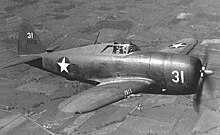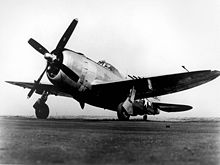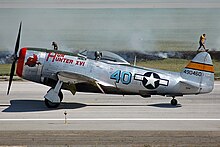Republic P-47
| Republic P-47 Thunderbolt | |
|---|---|
 P-47N Thunderbolt |
|
| Type: | Fighter bomber |
| Design country: | |
| Manufacturer: | |
| First flight: |
May 6, 1941 |
| Commissioning: |
1942 |
| Production time: |
1942 to 1945 |
| Number of pieces: |
15,686 |
The Republic P-47 Thunderbolt was a single-seat fighter aircraft produced by the US manufacturer Republic Aviation and the heaviest single-engine fighter aircraft of World War II . The all-metal - means Decker was with over 15,600 machines in addition to the North American P-51 , the most produced US fighter this time.
The United States Army Air Forces (USAAF) used P-47s mainly in the European theater of war as a fighter-bomber . The letter “P” in the designation stands for fighter aircraft (English Pursuit), most recently as F-47N (see #Variants ).
interpretation
The P-47 was the further development of the design concept of fast all-metal aircraft developed by Alexander Procofieff De Seversky , which was implemented in several designs by the Seversky Aircraft Corporation from 1933 . After the De Seversky shares were bought up by other shareholders, the company was renamed Republic Aviation Company in October 1939 . Direct predecessors of the P-47 were the Republic drafts P-43 and P-44 , which, like all previous Seversky and Republic constructions , were designed by the chief designer Alexander Kartweli . In November 1940, the United States Army Air Corps (USAAC), from which the USAAF emerged the following year, ordered the two prototypes XP-47 and XP-47A. However, according to the first experience reports from the European theater of war, these turned out to be too weakly armed and not powerful enough and were therefore not produced in series. Kartweli then began work on the much larger and heavier XP-47B. Since the voluminous GE - turbocharger of the hull to be accommodated in the rear part had been the design as a means Decker chosen to below the cockpit and the through wing spars to lead to both sides of the suction funnel and the two exhaust pipes to the rear. Behind the intercooler , two charge air lines ran back to the carburetor on either side of the cockpit.
The maiden flight took place on May 6, 1941. The P-47 differed from its predecessor models, such as the Republic P-43, in terms of size, power and mass, which resulted from the use of the large Pratt & Whitney R-2800 twin star engine with turbocharger.
commitment
The P-47B, of which 171 copies were built, was not operational due to the limitations of its equipment and served as a trainer aircraft in the United States . The experience gained from the training sessions with the initially unreliable P-47 helped Republic to eliminate the “teething troubles” of the type.
The P-47C, built in 602 copies, was the first US fighter aircraft that the USAAF used in large numbers in the European theater of war from April 1943. However, the radius of action was not large enough to provide escort protection to the 8th Air Force bombers as far as the more distant destinations in the German Reich, so that the P-47 was of limited use as an escort fighter and ultimately by the North American P-51 was replaced.
Instead, the 9th Air Force , which mainly flew tactical missions , used the P-47 in increasing numbers as a fighter-bomber . Thanks to the particularly robust construction with the air-cooled radial engine, the P-47 were better suited for this than the P-51 with its liquid-cooled engine.
With their comparatively small radius of action, P-47s were only used in small numbers in the Pacific War .
On May 8, 1945, the day of the unconditional surrender of the Wehrmacht , one of the 19-year-old 2nd Lt. Henry G. Mohr from the 405th Fighter Group, 511th Squadron, flown P-47 in the Austrian Traunsee . Mohr was rescued by locals and survived. It was one of the last aircraft that the Allies lost in the war in Europe. This machine was lost until 2005 when it was found at a depth of 70 meters. In June 2017, the aircraft took off again after a successful restoration.
The Wehrmacht was able to restore some captured P-47s to airworthiness and use them in the Air Force's 2./Versuchsverband Ob.dL ("Wander circus Rosarius ") .
The air forces in Brazil, Chile, Colombia, the Dominican Republic, Ecuador, Mexico, Yugoslavia, Turkey and Peru used thunderbolts in some cases until 1966.
Tactical characteristics
Thanks to the high full-pressure altitude achieved with the turbocharger, the P-47 was very fast at altitudes over 8000 m and, despite its high weight, its climbing performance was on a par with that of the Focke-Wulf Fw 190 at high altitudes. The turbocharger also ensured at least average performance at medium and low altitudes, while opponents with mechanical charging for high-altitude performance or good performance at low and medium altitudes showed a significant drop in performance in the other area.
The roll rate of the P-47D was mediocre at up to 90 ° / s; the aileron control was retained even at high speeds, while the Messerschmitt Bf 109 had a significantly poorer roll rate in the high-speed range, so that the P-47 had an advantage there.
In a steep dive, the P-47 could accelerate quickly, but was limited in its top speed by vibration problems. Some pilots reported that the P-47 suddenly began to vibrate heavily and the elevator became ineffective. British tests showed that the P-47 became uncontrollable at a comparatively low Mach number. These tests led to the equipment of the P-47 with dive flaps, which improved the controllability and thus increased the maximum Mach number somewhat. Even after the introduction of the dive flaps - which alleviated the tactical disadvantage resulting from this problem - the Fw 190 and the Bf 109 were still superior in this regard. 30 German Air Force pilots shot down five or more P-47s.
It is true that P-47 pilots have reported breaking the sound barrier in a dive ; however, these reports are due to display errors of the airspeed indicator in the high-speed crash. However, some of the phenomena observed by pilots when they reach maximum Mach number are similar to those seen when they break the sound barrier.
statistics
These data were collected between March 1943 and August 1945.
- Missions flown: 545,575
- Missed ammunition
- 134,899,415 rounds .50 BMG caliber (12.7 mm)
- 59,657 missiles
- 132,482 tons of bombs
- Flight time: 1,352,810 hours
- Fuel consumption: 773,025,120 l
- Damage caused (claimed "claims" by the pilots):
- 7000 aircraft, 3752 of them in the air
- 1340 locomotives
- 86,000 trucks
- 6000 armored vehicles and tanks
- 60,000 wagons
The total losses on P-47s amounted to 1043 machines in the 8th Air Force.
variants
- XP-47B: prototype, one built
- P-47B: first production version, which was only used for training due to various deficiencies, 171 built, six 12.7 mm machine guns
- P-47C: improved P-47B, 602 built
- P-47D: Large-scale series version with a more powerful engine with water injection , increased performance thanks to a new type of propeller, eight 12.7 mm machine guns, improved all-round visibility thanks to the full-view hood (P-47D-RE block 25 to 30 and P-47D-RA block 26 to 40 ), Suspension for bombs, rockets and additional tanks, dorsal fin against loss of stability due to the full-view hood in late series, retrofitted in older series. 12,602 built, of which 6,289 with full-view pulpit
- XP-47E: a converted P-47B with cockpit with pressure compensation.
- XP-47F: A converted P-47B with laminar airfoil
- P-47G-CU: 354 Curtiss-built P-47Ds without a full view canopy
- XP-47H: a converted P-47D with a 16-cylinder Chrysler XIV-2220-1 (789 km / h) engine
- XP-47J: a converted P-47D with a Pratt & Whitney R-2800-57 (C) engine with CH-5 turbocharger, which reached a top speed of 811 km / h in August 1944. A converted P-47D as a prototype with a full view cockpit
- XP-47L: a converted P-47D-20 with internal fuel supply increased to 1402 l
- YP-47M: three converted P-47D with dive brakes
- P-47M: Interceptor with a more powerful engine with a new turbocharger, 130 built
- P-47N: Long-range fighter with a more powerful engine with a new turbocharger, enlarged wing with increased tank capacity, built in 1816 (5934 canceled at the end of the war)
At the time the designation systems were changed in 1948 , a few hundred P-47Ns were still in service, and from then on they were listed as F-47Ns . Some were still in service with the Air National Guard until 1955 .
production
Approval of the P-47 by the USAAF:
| Manufacturer | Type | 1941 | 1942 | 1943 | 1944 | 1945 | TOTAL |
|---|---|---|---|---|---|---|---|
| Republic, Farmingdale | XP-47B | 1 | 1 | ||||
| Republic, Farmingdale | P-47B | 171 | 171 | ||||
| Republic, Farmingdale | P-47C | 345 | 257 | 602 | |||
| Republic, Evansville | P-47D | 10 | 1,131 | 3,087 | 1,863 | 6.091 | |
| Republic, Farmingdale | P-47D | 2,770 | 3,745 | 6,515 | |||
| Curtiss, Buffalo | P-47G | 6th | 271 | 77 | 354 | ||
| Republic, Farmingdale | 1 | 1 | |||||
| Republic, Farmingdale | P-47M | 130 | 130 | ||||
| Republic, Evansville | P-47N | 149 | 149 | ||||
| Republic, Farmingdale | P-47N | 24 | 1,643 | 1,667 | |||
| Republic, Farmingdale | XP-72 | 2 | 2 | ||||
| TOTAL | 1 | 532 | 4,430 | 7,065 | 3,655 | 15,683 |
Technical specifications
| Parameter | P-47D | P-47M | P-47N |
|---|---|---|---|
| length | 11.01 m | 11.07 m | 11.0 m |
| Wingspan | 12.42 m | 12.43 m | 13.06 m |
| height | 4.32 m | 4.5 m | 4.47 m |
| drive | 18-cylinder double radial engine Pratt & Whitney R-2800 -59 "Double Wasp" | 18-cylinder double radial engine Pratt & Whitney R- 2800-57 | Pratt & Whitney R- 2800-73 18-cylinder double radial engine |
| power | 1865 kW (2535 hp) | 2058 kW (2798 hp) | 2058 kW (2798 hp) |
| Top speed | 686 km / h at 9150 m altitude | 762 km / h at 9750 m altitude | 752 km / h at an altitude of 9906 m |
| Cruising speed | 560 km / h | 500 km / h | 483 km / h |
| Range | 2720 km | 850 km | 3540 km |
| crew | 1 | ||
| Service ceiling | 12,800 m | 12,500 m | 13,000 m |
| Empty mass | 4860 kg | 4728 kg | 4990 kg |
| Takeoff mass | 6579 to 8800 kg | 6012 to 6930 kg | 7394 to 9390 kg |
| Armament | six or eight MG Browning M2 , .50 BMG (12.7 mm) caliber , two 1000- pound (454-kg) bombs; up to 1000 kg bombs or ten missiles |
||
Trivia
On May 28, 2016, a P-47 Thunderbolt crashed into the Hudson River in New York City . The machine belonged to the American Airpower Museum. As part of the 75th birthday of this aircraft type, it took off with a P-40 and an escort aircraft at Farmingdale Airport , Long Island. The pilot died on impact.
See also
literature
- Olaf Groehler : History of the Air War 1910 to 1980. Military publishing house of the German Democratic Republic, Berlin 1981.
- Manfred Jurleit: Republic P-47 "Thunderbolt". In: Wolfgang Sellenthin (ed.): Fliegerkalender der DDR 1984. Militärverlag der DDR, Berlin 1983, pp. 146–152.
- Gene B. Stafford, Don Greer: Weapons Arsenal - Thunderbolt P-47. Podzun-Pallas Verlag, Volume 30, ISBN 3-7909-0059-1 .
- Wilfried Copenhagen : Legendary Airplanes. Military publishing house of the German Democratic Republic, Berlin 1990.
Web links
- The P-47 at the USAF Museum ( November 1, 2012 memento in the Internet Archive )
- The P-47 Pilots Association (English)
- Design analysis of the company Republic Aviation Corporation with beautiful exploded drawings (English)
Individual evidence
- ↑ Crash on the last day of the war - The secret of the P47 in the Traunsee. (Report on the rescue) In: Spiegel.tv. Retrieved May 29, 2016 (requires Flash).
- ^ "Dottie Mae's first flight June 22nd 2017" (video of the first flight after restoration). Accessed July 1, 2017.
- ↑ P-47 Thunderbolt Killers. In: luftwaffe.cz. Retrieved May 29, 2016.
- ↑ 8th Air Force Combat Losses in World War II ETO Against the AXIS Powers. In: taphilo.com. Retrieved May 29, 2016.
- ^ John M. Andrade, US Military Aircraft Designations and Serials , Midland Counties Publ., 1979, p. 149
- ↑ Statistical Digest of the USAF 1946, p. 100 ff .; www.uswarplanes.net
- ↑ a b W. Copenhagen: Legendary Airplanes. 1990, p. 184.
- ↑ Lauren Gambino: Pilot dies after second world war plane crashes into New York's Hudson River. In: theguardian.com. May 28, 2016, accessed May 30, 2016 .











